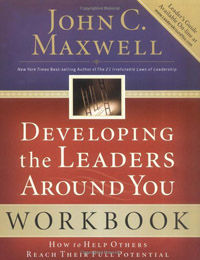|
| |||
Identifying Potential LeadersIdentifying Potential Leaders is a brief overview of the process of selecting the right people for the right positions. In other words, to identify potential leaders, you need to know what they look like. 
Identifying Potential LeadersThere is something more important and scarce than ability. It is the ability to identify potential ability. Also, you need to select the right people for the right positions. Ask yourself: what is needed? Who are the people here who are available? Who is able? Who is willing? Who gets things done? Maxwell calls this the list of the Five A's: Assessment of needs, Assets on hand, Ability of candidates, Attitude of candidates and Accomplishments of candidates. To select the right person or potential leaders for certain positions, you need to know what you are looking for. The following ten leadership qualities are a good place start. 1. CharacterCharacter is number one. Serious character flaws will eventually make a leader ineffective. Qualities that make up good character include honesty, integrity, self-discipline, teachability, dependability, perseverance, conscientiousness and a very strong work ethic. You can tell much about people's ability to lead others by checking out how well they manage their own lives. 2. InfluenceLeadership is influence. Leaders must know where they are going and they must be able to persuade others to go with them. 3. Positive AttitudeA positive attitude is one of the most valuable assets a potential leader can bring to a ministry. People who have a positive attitude are able to go places where others cannot. These people do things that others cannot and these people are not restricted by self-imposed limitations. 4. Excellent People SkillsTo put it bluntly, leaders without people skills will soon have no followers. People skills involve concern for others, an ability to understand others and an ability to interact with others. 5. Evident GiftsPeople have skills and abilities. Leaders recognize those skills and abilities when assessing someone for a leadership role. 6. Proven Track RecordPoet Archibald MacLeish once said, "There is only one thing more painful than learning from experience, and that is not learning from experience." Leaders who learn from their experience develop successful track records over time. 7. ConfidenceIf you are not a confidence leader, then people will not follow you. In fact, it is confidence that usually attracts people to you. Generally speaking, confidence is a characteristic of a positive attitude. Confident leaders are able to empower others. They instill within others confidence in themselves. 8. Self-DisciplineLeaders are self-disciplined. They are in control and they take responsibility for their actions. Leaders who have self-discipline have identified goals and have plans in place to achieve those goals. 9. Great Communication SkillsLeaders must have the ability to communication effectively. Effective communication builds confidence in the people around you. Never underestimate the importance of effective communication. 10. Discontent With the Status QuoStatus Quo is Latin for "the mess we're in." Raymond Smith of the Bell Atlantic Corporation once said, "Taking the safe road, doing your job, and not making waves may not get you fired (right away, at least) but it sure wont' do much for your career or your company over the long haul. We're not dumb. We know that administrators are easy to find and cheap to keep. Leaders - risk takers - are in very short supply. And ones with vision are pure gold." Donna Harrison said, "Great leaders are never satisfied with current levels of performance. they constantly strive for higher and higher levels of achievement." John Maxwell added, "They move beyond the status quo themselves and they ask the same of those around them." For more information about this subject, click on identifying potential leaders. Related Resources and TipsBecoming A Christian Leader: Becoming a Christian Leader outlines the qualities and abilities of those people who have the potential to be Church leaders. Collaborative Leadership Style: Collaborative Leadership Style is about working together and adding value and synergy to the team. In other words, collaborative leaders style is about completing one another not competing with one another. Discovering The Leadership Styles: Discovering the Leadership Styles examines the biblical gift of leadership and how that gift of leadership is expressed in different ways. Leadership Ability Determines Leadership Effectiveness: Leaders Ability Determines Leadership Effectiveness is a concept that John C. Maxwell develops in The Law of the Lid. In other words, to increase your effectiveness, you need to raise your level of leadership. The Law of the Big Picture : The Law of the Big Picture states that the goal is more important than the role. In other words, if the team is to reach its potential, each member must be willing to subordinate his personal goals to the good of the team. The Stakes of Leadership: The Stakes of Leadership is an article that looks at the importance of leadership in the local church. After all, the local church is the hope of the world. What Leaders Do: What Leaders Do is a brief explanation of the six primary areas of activity associated with Christian leadership in the Church. Developing Skills for Church Leadership is associated with knowing these six primary areas of activity. Who Is Your Toughest Leadership Challenge: Who Is Your Toughest Leadership Challenge examines The Art of Self-Leadership. The most overlooked area of leadership is this area of self-leadership. After all, the toughest management challenge is always yourself. |
SEARCH THIS SITE
|
||
 |
|||
|
Return to top
Homepage | Free Topical Sermons | Free Expository Sermons | Free Evangelistic Sermons | Free Christmas Sermons Free Easter Sermons | Free Mothers Day Sermons | Free Short Sermons | Free Sermonettes | Free Wedding Messages Free Sermons For Young People | Free Sermons For Youth | Free Sermons For Children | Free Online Sermons Free Sermon Outlines | Free Sermon Illustrations | Sermons Sermons Sermons | How To Write A Sermon | How To Write A Sermon Outline Writing A Funeral Sermon | Web Builders For Churches | Web Hosting For Churches | Web Design For Churches | Web Pages For Churches Web Keywords For Churches | Google Adsense For Churches | Site Map Disclaimer/Disclosure | Sermon Information |
|||
|
© Copyright 2008 -
All Rights Reserved No reproduction permitted without permission www.more-free-online-sermons.com Identifying Potential Leaders | |||


